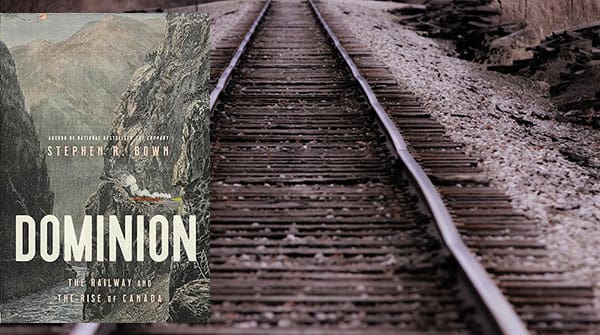New book depicts the history of the Transcontinental Railway and sheds light on its significance for the development and growth of Canada
 Is Canada boring? Don’t you believe it.
Is Canada boring? Don’t you believe it.
Canada’s origins were marked by a remarkable undertaking – the construction of a transcontinental railway. This ambitious venture introduced us to a cast of vibrant characters, among them the legendary Labrador Smith. However, it’s the meticulous work of authors like Stephen Bown that provides us with the intricate details of this epic journey.
In Stephen Bown’s book, Dominion: The Railway and the Rise of Canada, a fascinating snapshot of history emerges. In 1870, delegates striving to reach Ottawa from British Columbia embarked on an arduous voyage, employing a diverse array of modes of transportation. From boats to “screeching Red River carts,” dogsleds, and foot travel, their journey was nothing short of exhausting, leaving them in dire need of a haircut and a tailor.
That said, there’s actually a lot to be said about being bored in a country. While the American Civil War boasts a spectacular narrative, complete with the abolition of racial slavery, history suggests that everyone would have been better off had it never occurred.
Magna Carta is a tale you might be sorry you missed. But if Canada is a bit of a plod at times, the construction of the Canadian Pacific Railway stands out as a monumental epic in its history. This narrative unfolds from the early days of our often boozy first prime minister right down to the second Riel Rebellion, which ultimately rescued the railway project and its supporters from potential personal and even national catastrophe.
As Bown’s storytelling reveals, Canada’s history teems with excitement, adventure, and really wild things. They include a party of Overlandersheading West reduced to eating off the land with help from the locals. One Overlander even declared that “his skunks had been a slandered and much abused individual” after a meal of the same. Moreover, frontier “whiskey” of that era, concocted from “a toxic concoction of pure alcohol, ink, tobacco juice, pepper, laudanum and any other thing tossed into the pot to make it bitter and strong,” somehow played a role in Canada’s emergence.
The book is delightfully full of unexpected insights, often as throwaway lines, such as “Capitalism was the original crowdsourcing, a means to pool resources to undertake projects grander and more complex than any individual could afford.”
And five chapters in, Bown suddenly and plausibly argues that “Dynamite and its subsequent improvements and variations made possible the modern industrial world.”
Once the volatility of nitroglycerin was tamed, at least partly, by mixing with inert clays, its enormously greater explosive power over “black powder” allowed engineering feats that included the Canadian Pacific Railway.”
Damon Runyon once said all life is six to five against. Much of history is, too, and the colourful tales of Canada include some characters much less likely by far.
Take the ubiquitous mixed-race guide Jerry Potts, fluent in seven languages yet notably taciturn, a key translator between Europeans and aboriginals, of whom one North-West Mounted Police corporal said, “The chief difficulty about his interpretations was that, after he had interpreted from the Blackfoot into the English language, you weren’t very much further ahead, for his English was weird.”
Editors of Canadian history magazines face the awkward possibility of running the same eight or nine core features, including the CPR, Vimy Ridge, the building of a national railway, those seven painters, this big First World War battle where we became a nation, some social injustice, the Halifax Explosion, the Famous Five, a drunken PM and his big railroad.
Yet in revisiting the overly familiar CPR mogul William van Horne with his huge cigars, Bown produces what were for this reviewer new details, including Van Horne being a talented violinist and painter with sophisticated interests in architecture, botany, fossil collecting and cataloging, landscape gardening, Japanese porcelain, and French impressionism. And that he insisted, with considerable success, on providing railway workers facing backbreaking toil, miserable conditions and enormous risks with abundant, good-quality food.
As for Louis Riel, another standby, Bown is commendably even-handed.
He calls shooting Thomas Scott a catastrophic blunder yet convincingly suggests it would have occurred to almost anyone who ever had dealings with that wretched man. Furthermore, Bown depicts the Riel of 1885 as clearly out of his mind and tragically miscast in the events then unfolding in the Canadian West.
Bown acutely observes that the land survey that triggered the second upheaval “was the beginning of a tradition that has echoed down the ages, a tradition whereby Canadians are governed, at least in certain aspects, by what can only be described as an ineptocracy.” So not a tale of cultural imperialism, settler-colonial oppression or something else paranoid and one-sided. A tale of smug blunders.
A kind of reflexive wokeness keeps trying to hijack the narrative. Bown starts by calling the CPR “a great triumph of imagination, vision, politics and engineering, as well as a horrible environmental and social tragedy.”
Was it really? Would the world be a much better place socially and environmentally if the railroad had never been attempted or had failed as ignominiously as it repeatedly seemed about to do?
Brown makes one of his oddest comments in the introduction: “In recent years, Canadian history has been given a rude and long overdue awakening from the slumber of certainty.”
Certainty of what? That we are all born red Tories? The Innes school? Nobody knows. But he’s too good a writer and too honest a scholar to let it derail him.
His colourful cast includes people such as Sir Matthew Begbie, a frontier judge in BC with amazingly enlightened views on race. And Donald Alexander “Labrador” Smith, whom Bown believably portrays as greedy and unscrupulous, but adds that he established “the Donalda program for the purpose of providing higher education for Canadian women,” among many other major philanthropic ventures.
And much further along, he comments wistfully that men such as Smith, who made a vast fortune from humble origins despite much apparent bad luck, “believe their money is their servant, awaiting a gesture to do their bidding and provide them with whatever they desire.
But mostly they are mistaken. Their fortunes become their masters, consuming their thoughts and commanding their lives, the shadowy overseer. They become consumed with nurturing, defending and growing their wealth as if it were a living thing, a selfish, demanding thing that cannot be put from their mind.”
The author gives us a predictably lyrical depiction of the life of the ‘noble savage.’ But his account of the controversial Tsilhqot’in raids mentions that the generally admirable chief Klatsassin “had two wives, one of whom was a young girl recently captured in a raid against the nearby Dakelh,” and that “The Tsilhqot’in were an aggressive or even warlike people in the estimation of their neighbours and their raiding and capturing of others for slaves was a common complaint. Attacking unarmed sleeping civilians doesn’t seem very noble or brave.”
At one point, after persuasively depicting the appalling as well as pitiful “wolfers” (bounty hunters), often U.S. Civil War veterans suffering unemployment and PTSD, he has a band of wise, noble Cree come along and in stoic, harmonious fashion steal their horses.
Brown also takes the obligatory shot at residential schools but then adds, “The moral certainties of any age, including our own, will lead to similar problems for future people who view the world differently.”
Including, arguably, his view that labour on the railway was gratuitously brutal and dangerous. But then he unexpectedly and profoundly adds that “despite the hardships, the human spirit rose to find joy in even the bleakest of situations,” including the songs and tales around the campfires.
Toward the end, Bown has an outburst of relativism, saying we can’t judge history, that “What’s right and what’s wrong doesn’t just depend on who you are but when and where you are as well. Everything is changing all the time, including ourselves, including society. At some level in history there is no good or evil, just what happened. It’s up to us to do what we want with knowledge of past events.”
No it’s not. And he doesn’t believe it, as his wistful comments on the vanishing of the rich and complex aboriginal way of life underline.
A few pages later he rightly insists “People must have the courage to contend with the good, the bad and the ugly of everything to make sense of the world and plan for a better future.”
As he immediately adds, the point isn’t to “argue over whether certain historical decisions and actions were good or bad. Of course they were bad, or at least their outcome was. Rather, the question is: were these bad things done by evil people who should just be banished? Or were these actions the mostly banal behaviours of people who believed they were working toward a greater good?”
Indeed. If “so-called Canada” is a bag of toxic dirt, it should be dumped out as quickly as possible. But if it’s a remarkable tale of people struggling against long odds to make a better world and, with some notable exceptions, succeeding, it’s an improving tale as well as, Bown makes clear, a riveting one.
John Robson is a senior fellow at the Aristotle Foundation for Public Policy, an adjunct professor at Augustine College, and an author, historian, columnist and documentary filmmaker.
For interview requests, click here.
The opinions expressed by our columnists and contributors are theirs alone and do not inherently or expressly reflect the views of our publication.
© Troy Media
Troy Media is an editorial content provider to media outlets and its own hosted community news outlets across Canada.


